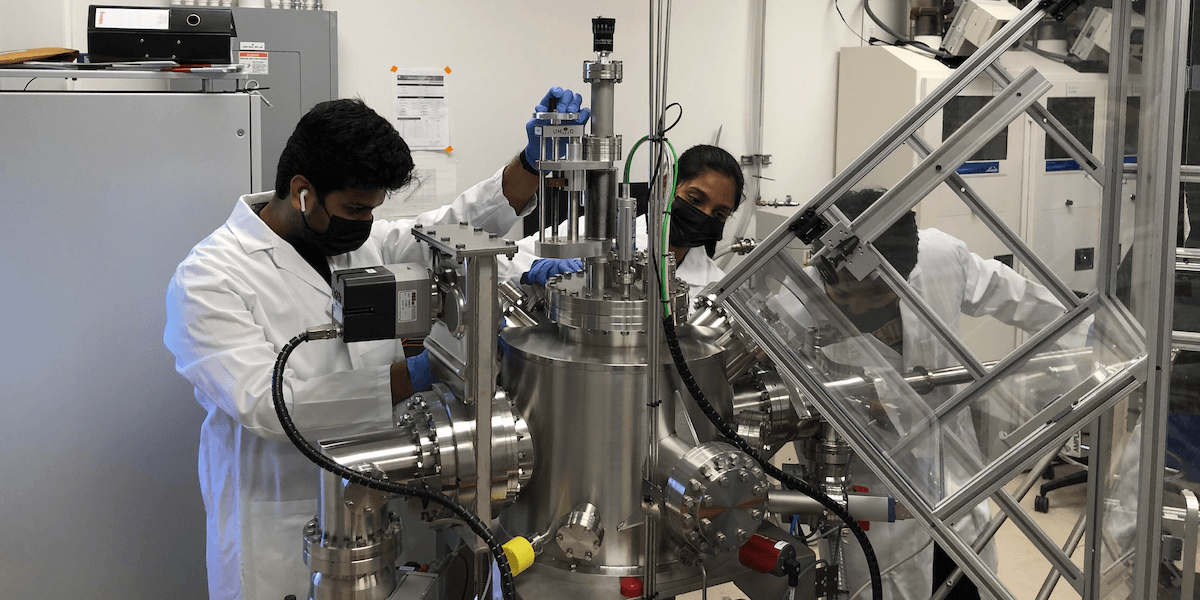
Jay Ravichandran’s Laboratory for Complex Materials and Devices
The Defense University Research Instrumentation Program, which supports university research infrastructure has elected to fund four research projects at USC Viterbi. The projects span a broad range of topics including brain modeling, emerging materials, new fuels, and automating the design of electromagnetic devices.
The Viterbi researchers were among 144 university researchers selected by the Department of Defense. The researchers whose proposals were selected include Jean Marie Charles Bouteiller, Stephen Cronin, Jayakanth Ravichandran, and Constantine Sideris. The projects are as follows.
Jean Marie Charles Bouteiller
Project: “Efficient scale-bridging methodologies for multi-scale modeling of the nervous system”
Research Assistant Professor of Biomedical Engineering, Jean-Marie Charles Bouteiller, studies how the nervous system functions in health and disease. As such, Bouteiller is modeling neuronal dynamics and synaptic transmission in the brain with great detail – thereby allowing to study the effects of drugs on different aspects of nervous system function. Given the complexity at play, Bouteiller attempts to use mathematical models capable of predicting chemical interactions in the brain with high level of realism and reduced computational footprint. Says Bouteiller, “The nervous system is inherently complex and multiscale – we need to find the right tools to model it: we need to get rid of the superfluous complexity and extract the gist to accurately model nervous system activity and its interactions with drugs to predict their effects on its health and functions.” Bouteiller is also attempting to understand the interplay between the brain electrical and chemical activity and compounds such as pesticides in order to understand their effects on neurodegeneration.
The award will allow his lab to have more computational power to speed up and facilitate the development of more predictive models.
Stephen Cronin
Project: “Widely Tunable Ultrafast Photon Source for Interrogation of Hot Electron-driven Electrochemical and Photocatalytic Processes”
Funded by ARO, the lab of Stephen Cronin, professor of Electrical Engineering, Physics, and Chemistry, is studying the photoconversion of greenhouse gasses into hydrocarbon fuels. Says Cronin about this project, “I am most excited about using this laser to explore new forms of chemistry driven by photoexcited electrons on metal surfaces. Most of our previous work has been limited to steady state spectroscopy. This laser will enable us to extend our study into the time domain and explore the dynamics and timescales on which these chemical reactions occur.”
Jayakanth Ravichandran
Project: “Growth and In Situ Characterization of Thin Films of Vapor Pressure Mismatched Perovskite Chalcogenides”
For Jayakanth Ravichandran, Assistant Professor of Chemical Engineering and Materials Science and Electrical and Computer Engineering and the Philip and Cayley MacDonald Early Career Chair, the award, funded by AFOSR, will help support the development of a new class of materials that will enable secure communication and energy efficient electronics. In addition, it will help the development of new materials that can improve infrared sensing and imaging. This project in Ravichandran’s Laboratory for Complex Materials and Devices, is related to work that was funded by a multi-university research initiative earlier this year for developing materials that support secure communication, sensing, and memory and storage in devices.
Constantine Sideris
Project: “Advanced Petascale Numerical Methods for Solution and Inverse Design of Massive Computational Physics Problems”
Funded by the AFOSR, this award will enable Sideris’ Analog/RF Integrated Circuits, Microsystems, and Electromagnetics (ACME) Laboratory to build a GPU-based (Graphics Processing Unit) high-performance computing cluster to advance research in computational electromagnetics.
Sideris, Assistant Professor of Electrical and Computer Engineering and holder of a Viterbi Early Career Chair, says: “The cluster will allow us to develop and run highly parallelized algorithms for simulating and automating the design of very large and complex electromagnetic structures, such as nanophotonic devices and radio-frequency antenna arrays.” Such devices are ubiquitous in today’s technology and impact many applications such as wireless telecommunications and sensing systems. Unfortunately, electromagnetic devices tend to be notoriously challenging to design manually even for experienced engineers. Improved designs with higher efficiencies, lower costs, and smaller sizes have become crucially important to keep up with society’s rapidly growing performance demands on technology. This project aims to develop algorithms which can synthesize new electromagnetic devices given only desired performance specifications as inputs, which can exceed the performance of human-designed devices and save time from tasks that require manual design.
Published on December 17th, 2021
Last updated on December 17th, 2021












